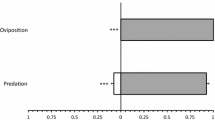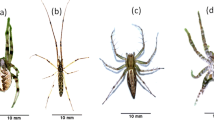Summary
Feeding experiments with 2,520 prey animals show differences in consumption rate and palatability for four spider species (Zygiella x-notata, Linyphia triangularis, Tegenaria atrica, Pholcus phalangioides). A possible protection against predators by chemical defence is discussed with special regard to 30 species of Heteroptera. Chemical weapons possess an astonishingly low deterrent effect whereas thick chitinisation (Coleoptera) is found to give very effective protection. Studies of the actual prey of these webbuilding spiders gave similar results in Araneidae and Linyphiidae. Nematocera and Homoptera are the most important prey group. Hymenoptera, Coleoptera and Brachycera were seldom caught. In contrast to this, the prey of Tegenaria and Pholcus consists mainly of Brachycera, Coleoptera and Hymenoptera, whereas Nematocera and Homoptera are rarely caught. The prey animals are mostly of small size. Only Pholcus and Tegenaria catch larger specimens. An ecological classification of the prey of Linyphiidae and Araneidae shows high percentages of phytophagous and detritophagous insects. Compared to the potential prey (trap data), predators, parasites and pollinating insects are underrepresented in the actual prey.
Similar content being viewed by others
References
Bailey C, Chada H (1968) Spider populations in grain sorghum. Ann Ent Soc Am, College Park, 61:567–571
Bristowe W (1941) The comity of spiders. Vol 2, London, The Ray Society
Brown K (1981) Foraging ecology and niche partitioning in orbweaving spiders. Oecologia, Berlin, 50:380–385
Carico J (1978) Predatory behaviour in Euryopis funebris (Hentz) (Araneae: Theridiidae) and the evolutionary significance of web reduction. Symp Zool Soc London, 42:51–58
Crome W (1937) Bau und Funktion des Spinnapparates und Analhügels, Ernährungsbiologie und allgemeine Bemerkungen zur Lebensweise von Uroctea durandi (Latreille) Zool Jb Syst, 85:571–606
Eberhard W, Barreto M, Pfizenmaier W (1978) Web robbery by mature male orb-weaving spiders. Bull Br Arachnol Soc, 4:228–230
Eisner T (1970) Chemical defence against predation in arthropods. In: Sondheimer E, Simeone J (eds). Chemical ecology. Academic press, New York
Gettmann W (1978) Untersuchungen zum Nahrungsspektrum von Wolfspinnen (Lycosiden) der Gattung Pirata. Mitt Dt Ges Allg Angew Ent, 1:63–66
Greenstone M (1978) The numerical response to prey availability of Pardosa ramulosa (Araneae: Lycosidae) and its relationship to the role of spiders in the balance of nature. Symp Zool Soc London, 42:183–193
Harkness R (1977) Further observations on the relation between an ant, Cataglyphis bicolor (F.) (Hym. Formicidae) and a spider, Zodarium frenatum (Simon) (Araneae, Zodariidae). Ent Mon Mag, 112:111–121
Holzapfel M (1932) Die Gewächshausfauna des Berner Botanischen Garten. Rev. Suisse Zool, Genf, 39:325
Kajak A (1965) An analysis of food relations between the spiders Araneus cornutus and A. quadratus and their prey in meadows. Ekol Pol A, 13:717–768
Kullenberg B (1944) Studien über die Biologie der Capsiden. Zool Bidr Uppsala, 23:1–522
Moulder B, Reichle D (1972) Significance of spider predation in the energy dynamics of forest-floor arthropod communities. Ecol Monogr, 42:473–498
Nakamura K (1972) The ingestion in wolf spiders. II. The expression of degree of hunger and amount of ingestion in relation to spider's hunger. Res Popul Ecol, 14:82–96
Nakamura M, Nakamura K (1977) Population dynamics of the chestnut gall wasp (Cynipidae, Hym.). 5. Estimation of the effect of predation by spiders on the mortality of imaginal wasps based on the precipitin test. Oecologia, Berlin, 27:97–116
Nentwig W (1980 a) The selective prey of Linyphiid-like spiders and of their space webs. Oecologia, Berlin, 45:236–243
Nentwig W (1980b) Wie funktionieren Spinnennetze. Biologie in unserer Zeit, Weinheim, 10:117–119
Nentwig W (1981) Insekten, Spinnennetze und Netzspinnen. Marburger Ent Publ, Marburg, 1 (5) 1–139. Thesis, University of Marburg
Nentwig W (1982) Why do only certain insects escape from a spider's web? Oecologia, Berlin, 53,412–417
Nyffeler M, Benz G (1978) Die Beutespektren der Netzspinnen Argiope bruennichi, Araneus quadratus und Agelena labyrinthica in Ödlandwiesen bei Zürich. Rev Suisse Zool, (Genf) 85:747–757
Nyffeler M, Benz G (1979) Zur ökologischen Bedeutung der Spinnen der Vegetationsschicht von Getreide-und Rapsfeldern bei Zürich (Schweiz). Z Ang Ent, 87:348–376
Nyffeler M, Benz G (1981) Freilanduntersuchungen zur Nahrungsökologie der Spinnen: Beobachtungen aus der Region Zürich. Anz Schädlingskd Pflanzenschutz Umweltschutz (Berlin) 54:33–39
Pötzsch J (1966) Notizen zur Ernährung und Lebensweise von Meta menardi Latr. (Araneae, Araneidae). Abh Naturkundemus Görlitz, 41:1–23
Pointing P (1966) A quantitative field study of predatory behaviour by the sheet-web spider Frontinella communis on European pine shoot moth adults. Can J Zool (Ottawa) 44:256–273
Remold H (1962) Über die biologische Bedeutung der Duftdrüsen bei den Landwanzen (Geocorisae). Z Vgl Physiol, 45:636–694
Rothschild M (1961) Defensive odours and Mullerian mimicry among insects. Trans R Soc London, 113:101–121
Ruppertshofen H (1964) Über den Einsatz von Decken-und Radnetzspinnen im Forstschutz. Waldhygiene (Würzburg) 5:147–153
Schildknecht H, Winkler H, Maschwitz U (1968) Vergleichend chemische Untersuchungen der Inhaltstoffe der Pygidalwehrblasen von Carabiden. Z Naturforsch, 23 b:637–644
Tretzel E (1961) Biologie, Ökologie und Brutpflege von Coelotes terrestris (Wider) (Araneae, Agelenidae). Z Morph Ökol Tiere (Berlin) 49:658–745
Turnbull A (1960) The prey of the spider Linyphia triangularis (Linyphiidae). Can J Zool (Ottawa) 38:859–873
Weidemann G (1971) Die Stellung epigäischer Raubarthropoden im Ökosystem Buchenwald. Ver Dt Zool Ges, 65:106–116
Author information
Authors and Affiliations
Rights and permissions
About this article
Cite this article
Nentwig, W. The prey of web-building spiders compared with feeding experiments (Araneae: Araneidae, Linyphiidae, pholcidae, Agelenidae). Oecologia 56, 132–139 (1983). https://doi.org/10.1007/BF00378229
Received:
Issue Date:
DOI: https://doi.org/10.1007/BF00378229




